| Article ID | Journal | Published Year | Pages | File Type |
|---|---|---|---|---|
| 4095 | Biochemical Engineering Journal | 2010 | 9 Pages |
The recombinant strain of the yeast Candida famata 13-76 that overexpresses FMN1 gene coding for riboflavin kinase, accumulates significant amounts of flavin mononucleotide (FMN) in the cultural liquid. The effectiveness of FMN production by this strain under different conditions was evaluated. First, the medium composition was optimized in shake flask cultures. After preliminary experiments for nitrogen source selection, the two-level Plackett–Burman (PB) design was performed to screen medium components that significantly influence the FMN production. Among the 15 variables tested, KH2PO4, CaCl2, (NH4)6Mo7O24, CuSO4 and yeast extract, were identified as the most significant factors for FMN production (confidence levels above 95%). In order to investigate the quantitative effects for five variables selected from PB design on FMN production, a central composite design (CCD) was subsequently employed for further optimization. The optimization strategies used led to a 4.77-fold increase in the FMN production. A batch culture profile in a 1 L fermenter was consequently designed according to the optimal medium observed in shake flasks. A final FMN concentration of 231 ± 4.11 mg/L was obtained in 40 h, which further verified the practicability of the used strategy.
